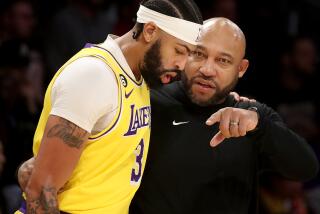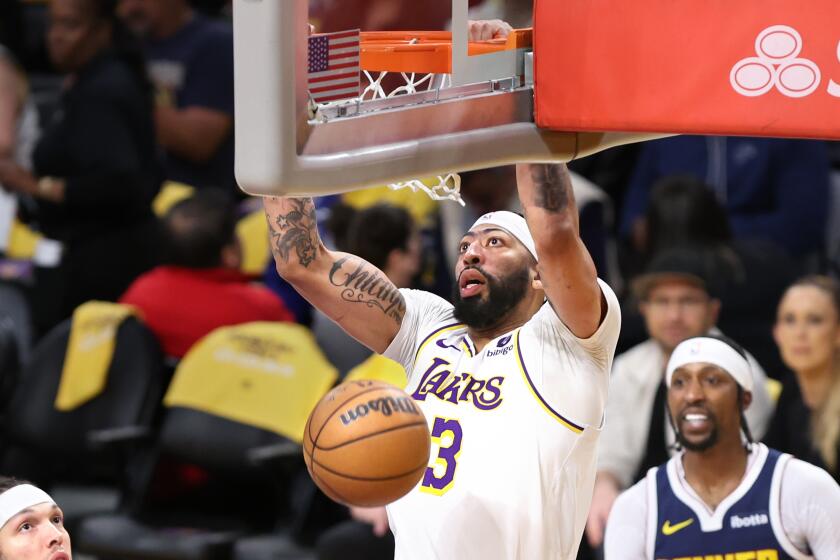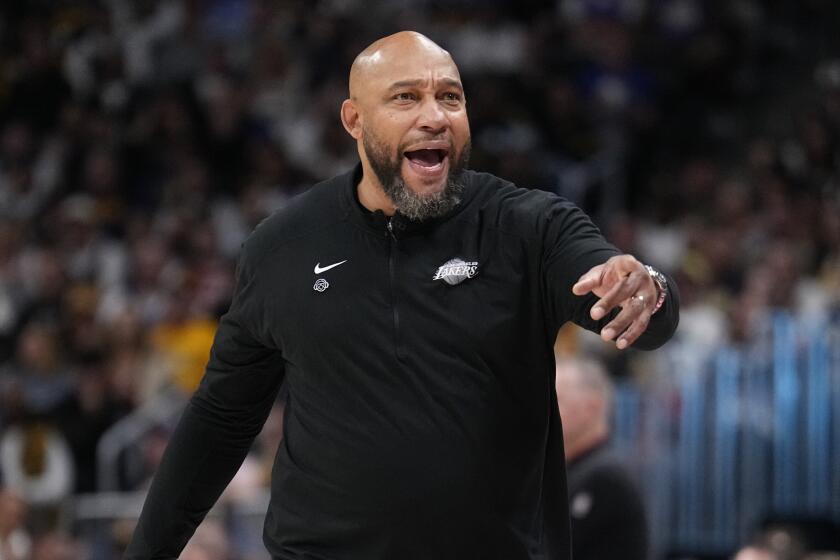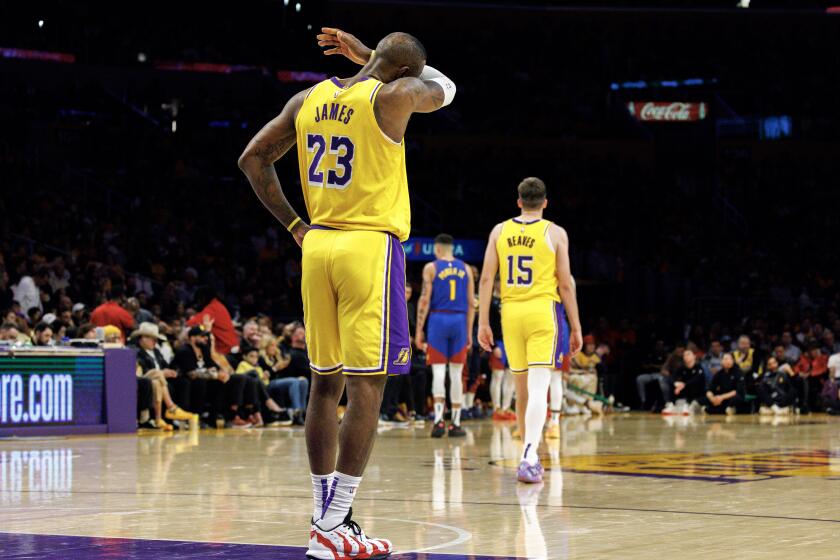When Reruns Get Canceled
The second go-round for the Lakers and Coach Phil Jackson began Tuesday at a Staples Center news conference that seemed like old times.
Their reunion again lifted Los Angeles to top billing nationally, overshadowing Game 3 of the NBA Finals in Auburn Hills, Mich., and providing star power the Lakers lacked while missing the playoffs this season without Jackson on the sideline.
Maintaining the buzz in second acts, however, is often difficult, and the team’s roster won’t prompt planning for a championship parade anytime soon.
But Jackson was eager to do it all again with the Lakers, becoming the newest member of sports’ high-profile “Second-Timers Club.”
“It’s a tremendous story,” he said. “... It’s a story of reconciliation, redemption and reuniting -- a lot of things in this make for a wonderful opportunity for ... the Lakers and myself.”
That’s the way these feel-good reunions usually begin.
John Robinson returned to USC amid high expectations in 1993 after nine years coaching the NFL’s L.A. Rams. USC hoped Robinson would revive its tarnished image, turning to a coach who had an .819 winning percentage, won three Pacific 10 titles and the 1978 national title in his first stint at Heritage Hall.
The blast from the past quickly boosted the Trojans’ spirits and the team improved, winning bowl games -- including the 1996 Rose Bowl -- in Robinson’s first three seasons back.
But that didn’t prevent an unhappy ending for him. He was fired in 1997 after USC went 12-11 in his final two seasons.
“Going back can be tougher than going elsewhere,” Robinson said.
“Probably the most difficult thing to do is evaluate the place for what it is at that moment, not what you remember it being,” said Robinson, who also coached and was athletic director at Nevada Las Vegas before retiring.
“If you were successful before, people are going to want to go back to the good old days. You probably do too. It’s human nature.
Gene Mauch had two successful stints with the Angels, albeit not as good as they could have been. He led the team to the American League West division title in 1982, but the Angels lost the best-of-five AL championship series to Milwaukee after winning the first two games.
Mauch was removed as manager after that season and wound up with a front-office job. He returned to the field in 1985 and a year later the Angels squandered a 3-1 lead in the best-of-seven ALCS to Boston.
Whether Joe Gibbs will be successful in his second turn with the Washington Redskins is still to be determined.
After coaching the Redskins to three Super Bowl victories in 12 seasons, Gibbs retired in 1993 with a 124-60 record, choosing to focus on his NASCAR racing team. The Redskins rehired him to replace Steve Spurrier last season, and Gibbs returned to an NFL that was much different than the league he left.
The off-season overhaul of rosters because of free agency and salary-cap issues, as well as major rules changes such as the two-point conversion and the option to challenge calls by officials, were not factors when Gibbs first guided the Redskins. Washington’s 6-10 record prompted reporters and fans to question whether Gibbs could thrive in today’s NFL.
“When you’re evaluating the situation, probably the most important thing to look at is whether the organization, as a whole, is committed to doing things the same way it used to,” said Robinson, commenting generally about coaches who return to places they had formerly worked. “You may want to believe they are, but they might do things differently now. Maybe they’re more willing to take shortcuts, or they just don’t do it the same way.
“When you first get a job, you go in and look around at the problems and say, ‘Well, if there weren’t any problems here they wouldn’t have hired me.’ You have do to the same thing the second time.”
Or in Billy Martin’s case, the third, fourth and fifth times.
The New York Yankees’ 1977 World Series title was the high point of Martin’s dizzying tenure as their manager. He resigned in July 1978, returned in June 1979 and was fired after that season.
Owner George Steinbrenner rehired Martin three more times before finally shutting the door in May 1988.
Operating under the Big Apple media microscope wasn’t helpful to Martin, but Jackson has demonstrated a skilled touch in that area while leading the Chicago Bulls and Lakers to nine NBA titles.
And in the second go-round, Robinson said, the spotlight burns brighter.
“I think everyone feels it somewhat, but I don’t think coaches really take issue with [outside expectations],” he said. “Coaches focus on executing their plan -- and that’s no different the first time or the second.”
Staff writer Robyn Norwood contributed to this report.
*
(BEGIN TEXT OF INFOBOX)
They returned
Some coaches/managers who left teams and then returned to lead them again:
BASEBALL
* George Bamberger, Milwaukee Brewers: Was hired as manager by the Brewers in 1977 and turned the team around, leading the club to 93-69 and 95-66 records in 1978 and 1979. He was able to manage only 92 games in 1980 because of a heart problem that required surgery. After managing the Mets in 1982 and 1983, Bamberger returned to manage the Brewers in 1985 (71-90) and 1986 (77-84).
* Billy Martin, New York Yankees: Became manager in August 1975 and led the team to a World Series victory in 1977. He resigned in July 1978 and five days later announced he would return in 1980. He came back sooner, in June 1979. Martin was fired at the end of the season. He was rehired by the Yankees in 1983, fired at the end of the season, rehired in 1985 and fired at the end of that season. He was rehired in October 1987 and fired in May 1988. Martin never made it back to the World Series after 1977.
* Gene Mauch, Angels: Hired in May 1981, led club to a 93-69 record and American League West division title the following season. The Angels won the first two games of a best-of-five playoff series against the Brewers, then lost the pennant with three consecutive losses, and Mauch was fired. Mauch was rehired in 1985, and the Angels finished second in the AL West by one game. The Angels reached the playoffs the next season, only to blow a 3-1 lead in the best-of-seven AL championship series against Boston. He managed one more season before resigning.
*
BASKETBALL
* John Kundla, Minneapolis Lakers: After nine seasons, four NBA titles and a 434-268 record, Kundla was moved up to general manager before the 1957-58 season so recently retired center George Mikan could become coach. After a 9-30 start, Mikan was relieved of his duties and Kundla was reinstalled as coach. The Lakers did little better after Kundla’s return, going 10-23 and finishing with the league’s worst record, giving them the first pick in the draft. They picked Elgin Baylor, who led the Lakers to the NBA Finals in 1959. Kundla retired after the season to coach his alma mater, the University of Minnesota.
*
FOOTBALL
* George Allen, Rams: After guiding the Rams to three winning seasons (8-6, 11-1-2, 10-3-1), Allen was fired by owner Dan Reeves, who cited a personality conflict. Los Angeles fans were shocked, and 7,500 signed up for a citizens’ committee to save Allen’s job. Many sent carbon copies of requests to cancel their season tickets. Overwhelming support came from Allen’s players. At a news conference the day after the firing, 12 Rams stood behind him to show their loyalty. Thirty-eight of the 40 players on the roster backed the coach, including stars such as defensive ends Deacon Jones and Lamar Lundy, quarterback Roman Gabriel and linebacker Jack Pardee, who said they would retire if Allen was not rehired. A week after the firing, Allen got his job back. He coached the Rams to 11-3 and 9-4-1 records the next two seasons before he was fired again.
* Joe Gibbs, Washington Redskins: Gibbs coached Washington to three Super Bowl victories in 12 seasons, retiring after the 1992 season with a 124-60 record. Gibbs created his NASCAR team, Joe Gibbs Racing, in 1991. Gibbs returned to the Redskin sidelines in 2004 and finished 6-10 in a rebuilding season.
* Chuck Knox, Rams: Knox guided the Rams to five NFC West division titles in five years but lost three consecutive NFC championship games, from 1974 through 1976, and was fired after the last failure. After stints with Buffalo and Seattle, Knox returned to coach the Rams in 1992 and went 6-10, 5-11 and 4-12 in three seasons.
* Frank Leahy, Notre Dame: Hired in 1942, Leahy posted records of 7-2-2, 9-1 and 8-2. He entered the Navy in 1944 and after two years of service returned to Notre Dame in 1946. He stayed until resigning for health reasons in 1954. Leahy finished with six undefeated seasons, five national championships and an unbeaten string of 39 games in the late 1940s.
* John Robinson, USC: Hired in 1976, Robinson spent seven seasons with the Trojans before leaving to coach the Rams. Robinson had an .827 winning percentage at USC, won the 1978 national championship and led the Trojans to three Pacific 10 Conference championships and five bowl games. From 1978 to 1980, USC posted a school-record 28-game unbeaten streak. Robinson was rehired by USC in 1993 and stayed through 1997, winning three bowl games. Robinson was 67-14-2 in his first stint at USC and 36-21-2 in his second.
*
HOCKEY
* Glen Sather, Edmonton Oilers: Was coach and general manager when the Oilers won four Stanley Cups from 1984 to 1988. Edmonton won a fifth Cup in 1990 with Sather as general manager. He replaced Ted Green as coach after 24 games of the 1993-94 season and went 22-27-11 the rest of the way. He returned to the front office the next season.
Los Angeles Times
More to Read
All things Lakers, all the time.
Get all the Lakers news you need in Dan Woike's weekly newsletter.
You may occasionally receive promotional content from the Los Angeles Times.






